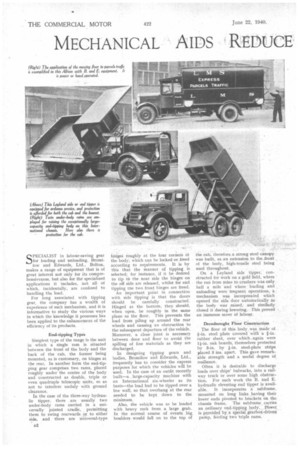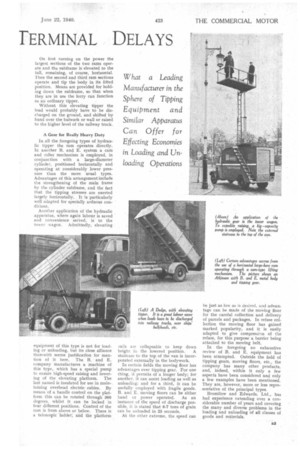MECHANICAL AIDS RMUCE
Page 28

Page 29

If you've noticed an error in this article please click here to report it so we can fix it.
TERMINAL DELAYS
SPECIALIST in labour-saving gear for loading and unloading, Bromilow and Edwards, Ltd., Bolton, makes a range of equipment that is of great interest not only for its comprehensiveness, but also for the specialized applications it includes, not all of which, incidentally, are confined to handling the load.
For long associated with tipping gear, the company has a wealth of experience of such mechanism, and it is informative to study the various ways in which the knowledge it possesses has been applied to the enhancement of the efficiency of its products.
End-tipping Types Simplest type of the range is the unit in which a single ram is situated between the front of the body and the back of the cab, the former being mounted, as is customary, on hinges at the rear. In another form the end-tipping gear comprises two rams, placed roughly under the centre of the body and constructed as double, triple or even quadruple telescopic units, so as not to interfere unduly with ground clearance.
In the case of the three-way hydraulic tipper, there are usually two under-body rams carried in a universally jointed cradle, permitting them to swing rearwards or to either side, and there are universal-type hinges roughly at the four corners of the body, which can be locked or freed according to requirements. It is by this that the manner of tipping is selected; for instance, if it be desired to tip to the near side the hinges on the off side are released, whilst for end tipping the two front hinges are freed.
An important point in connection with side tipping is that the doors should be carefully constructed. Hinged at the bottom, they should, when open, be roughly in the same plane as the floor. This prevents the load from piling up around the rear wheels and causing an obstruction to the subsequent departure of the vehicle. Moreover, a close joint is necessary between door and floor to avoid the spilling of fine materials as they are discharged.
In designing tipping gears and bodies, Bromflow and Edwards, Ltd., frequently has to consider the express purposes for which the vehicles will be used. In the case of an outfit recently built—a . large-capacity machine with an International six-wheeler as its basis—the load had to be tipped over a low wall, so that overhang at the rear needed to be kept down to the minimum.
Also, the vehicle was to be loaded with heavy rock from a large grab. In the normal course of events big, boulders would fall on to the top of the cab, therefore a strong steel canopy was built, as an extension to the iront of the body, high-tensile steel being used throughout.
On a Leyland side tipper, constructed for work on a gold field, where the run from mine to crushers was only half a mile and where loading and unloading were frequent operations, a mechanism was incorporated which opened the side door automatically as the body was raised, and similarly closed it during lowering. This proved an immense saver of labour, Dreadnought Floor Construction The floor of this body was made of Fin. steel plate covered with a i-in. rubber sheet, over which..again were 11-in, oak boards, themselves protected by 3-in. by 1-in, steel-plate strips placed 3 ins. apart. This gave remarkable strength and a useful degree of resilience.
Often it is desirable to discharge loads over ships' bulwarks, into a railway truck or over some high obstruction. For such work the B. and E. hydraulic elevating end tipper is available. It incorporates a subframe. mounted on long links having their lower ends pivoted to brackets on the chassis frame. The subframe carries an ordinary end-tipping body. Power is provided by.a special gearbox-driven pump, feeding two triple rams. On first turning on the power the largest sections of the two rams operate and the subframe is elevated to the lull, remaining, of course, horizontal. Then the second and third ram sections operate and tip the body in its lifted position. Means are provided for holding down the subframe, so that when they are in use the lorry can function as an ordinary tipper.
Without this elevating tipper the load would probably have to be discharged on the ground, and shifted by hand over the bulwark or wall or raised to the higher level of the railway track.
A Gear for Really Heavy Duty In all the foregoing types of hydraulic tipper the ram operates directly. In another B. and E. system a cam and roller mechanism is employed, in conjunction with a large-diameter cylinder, positioned horizontally and operating at considerably lower pressure than the more usual types. Advantages of this arrangement include the strengthening of the main frame by the cylinder subframe, and the fact that the tipping stresses are exerted largely horizontally. It is particularly well adapted for specially arduous conditions.
Another application of the hydraulic apparatus, where again labour is saved and convenience served, is to the tov,er wagon. Admittedly, elevating
equipment of this type is not for loading or unloading, but its close alliance therewith seems justification for mention of it here. The B. and E. company manufactures a machine of this type, which has a special pump to ensure high-speed raising and lowering of the elevating platform. The last named is insulated for use in maintaining overhead electric cables. By means of a handle control on the platform this can be rotated through 360 degrees, whilst it can be locked in four different positions. Control of the ram is from above or below. There is a telescopic ladder, and the platform
rails are collapsable to keep down height in the lowered position. A staircase to the top of the van is incorporated externally in the bodywork.
In certain fields the moving floor has advantages over tipping gear. For one thing, it permits of a longer body; for another, it can assist loading as well as unloading; and for a third, it can be usefully employed with fragile goods. B. and E.. moving floors can be either hand or power operated. As an instance of the speed of discharge possible, it is stated that 6-7 tons of grain can be unloaded in 25 seconds.
At the other extreme, the speed can he just as low as is desired, and advantage can be made of the moving floor for the careful collection and delivery of parcels and packages. In refuse collection the moving floor has gained marked popularity, and it is easily adapted to give compressiqn of the refuse, for this purpose a harrier being attached to the moving belt, In the foregoing no exhaustive review of B. and E. equipment has been attempted. Outside the field of tipping gears, moving floors, etc., the company has many other products, and, indeed, within it only a few aspects have been considered and only a few examples have been mentioned. They are, however, more or less representative of the principal types.
Bromilow and Edwards, Ltd., has had experience extending over a considerable number of years and covering the many and diverse problems in the loading and unloading of all classes of goods and materials.




























































